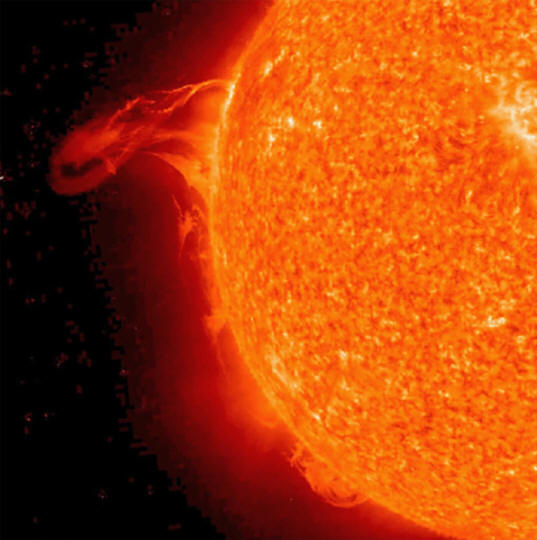Helios Awakens
Jun 14, 2010
The
Sun is beginning to rouse itself
from a long period of quiescence.
What a difference a year can make,
not only in our personal lives, but
also in the life of the Sun. It was
in June of 2009 that heliophysicists
were reporting a period of low
sunspot activity that had not been
seen in 100 years or more. There
were almost 800 days of inactivity
between sunspot cycles 23 and 24.
However, according to a June 13,
2010 report from Spaceweather.com,
sunspot number 1081 is "crackling"
with C-class and M-class solar
flares. Solar flares are categorized
as A, B, C, M, or X: light, medium,
or powerful, with a numerical
intensity from 1 through 9 attached.
The labels are primarily used to
illustrate the potential effects
that they might have on our planet.
Thus, an X-17 flare is considered
extremely intense, while a C-4 event
will have little effect on
satellites in Earth orbit or on
electric power grids.
As standard theories state, solar
flares, or coronal mass ejections
(CME), occur when magnetic loops in
the Sun's atmosphere known as
"prominences" connect with each
other, causing a short circuit. The
sudden release of "magnetic energy"
is often described as millions of
hydrogen bombs simultaneously
detonating inside a confined space.
Although no one knows what so-called
"magnetic reconnection" is, it is
the only explanation offered in
science journals for why those
gigantic solar explosions appear.
CMEs eject solar plasma in the
billions of tons. A hallmark of CME
ejections is an increase in auroral
brightness and frequency, since the
flares are composed of charged
particles. Although the majority of
researchers identify the stream of
ions pouring out of the Sun as a
"wind" and that the particles "rain
down" on Earth's magnetic field, the
fact that they are attracted to and
follow the polar cusps indicates
their electrical nature.
Solar flares are sometimes
observed to leave the Sun's surface
with unbelievable acceleration. In
the past, velocities more than
70,000 kilometers per second have
been clocked. The critical factor in
that measurement is that the solar
matter continued to accelerate as it
left the Sun. If shock waves were
responsible for the initial impetus,
then surely the blast would have
begun to decelerate as it moved
toward Earth. Since the opposite
effect was seen, there must be
another phenomenon at work other
than the forces that might propel a
cannonball, for instance.
In an Electric Universe populated
by electric stars the explanation
seems obvious: electric fields in
space can accelerate charged
particles and create coherent
electric currents. According to
conventional doctrine, the Sun
accelerates electrons (and protons)
away from its surface in the same
way that sound waves are amplified.
Energetic pulsations in the solar
photosphere travel upward through
"acoustical wave-guides," called
magnetic flux tubes, that
push “hot gas” outward. Giant
formations called
spicules
rise thousands of kilometers above
the photosphere and carry the hot
gas with them.
The Electric Universe hypothesis
is based on electrodynamic
principles and not on kinetic
behavior, or even electrostatic
models. The basic premise of this
alternative view is that celestial
bodies are immersed in plasma and
are connected by circuits. Since the
Sun is also "plugged-in" to the
galaxy and to its family of planets,
it behaves like a charged object
seeking equilibrium with its
environment.
In his exhaustive work, The
Physics of the Plasma Universe
,
Dr. Anthony Peratt describes
field-aligned currents in this way:
“...electric fields aligned along
the magnetic field direction freely
accelerate particles. Electrons and
ions are accelerated in opposite
directions, giving rise to a current
along the magnetic field lines.”
Solar flares could be thought of
as tremendous lightning bursts,
discharging vast quantities of
matter at near relativistic speeds.
How those flares generate such
highly energetic emissions is a
continuing mystery to
heliophysicists.
Early in the Twentieth century,
Nobel laureate Hannes Alfvén was
contracted by the Swedish Power
Company because some of the
rectifiers used in their power
transmission circuits had exploded
for no apparent reason. When they
shorted-out more energy was released
than was contained by the plasma
flow inside them. It was
subsequently discovered that the
power from an entire 900 kilometer
long transmission line had instantly
passed through the devices. The
result was catastrophic failure and
extensive damage. Alfvén identified
the cause as unstable double layers
within the plasma flow, otherwise
known as plasma instabilities.
The circuit connecting the Sun is
of unknown length, but probably
extends for thousands of
light-years. How much electrical
energy might be contained in such
magnetically confined “transmission
lines”? No one knows, but
astronomers are continually
“surprised” by the
incredible detonations
that they observe from solar flares.
As
the electric Sun theory
relates, sunspots, flares, coronal
heating, and all other solar
activity most likely results from
fluctuations in electrical input
from our galaxy.
Birkeland current filaments
slowly rotate past the Solar System,
supplying more or less power to the
Sun as they go.
Stephen Smith







